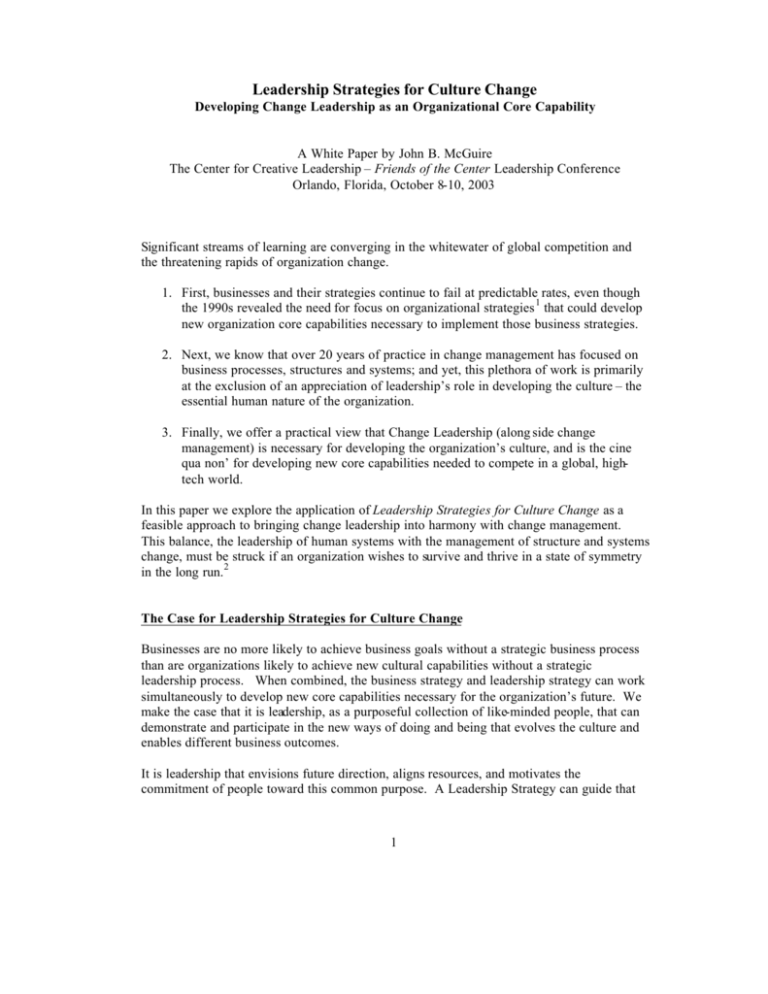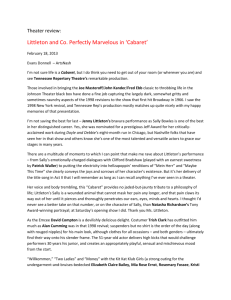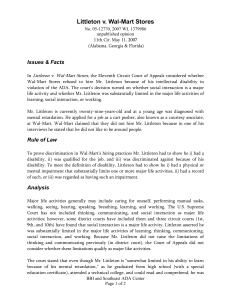Leadership Strategies for Culture Change
advertisement

Leadership Strategies for Culture Change Developing Change Leadership as an Organizational Core Capability A White Paper by John B. McGuire The Center for Creative Leadership – Friends of the Center Leadership Conference Orlando, Florida, October 8-10, 2003 Significant streams of learning are converging in the whitewater of global competition and the threatening rapids of organization change. 1. First, businesses and their strategies continue to fail at predictable rates, even though the 1990s revealed the need for focus on organizational strategies 1 that could develop new organization core capabilities necessary to implement those business strategies. 2. Next, we know that over 20 years of practice in change management has focused on business processes, structures and systems; and yet, this plethora of work is primarily at the exclusion of an appreciation of leadership’s role in developing the culture – the essential human nature of the organization. 3. Finally, we offer a practical view that Change Leadership (along side change management) is necessary for developing the organization’s culture, and is the cine qua non’ for developing new core capabilities needed to compete in a global, hightech world. In this paper we explore the application of Leadership Strategies for Culture Change as a feasible approach to bringing change leadership into harmony with change management. This balance, the leadership of human systems with the management of structure and systems change, must be struck if an organization wishes to survive and thrive in a state of symmetry in the long run. 2 The Case for Leadership Strategies for Culture Change Businesses are no more likely to achieve business goals without a strategic business process than are organizations likely to achieve new cultural capabilities without a strategic leadership process. When combined, the business strategy and leadership strategy can work simultaneously to develop new core capabilities necessary for the organization’s future. We make the case that it is leadership, as a purposeful collection of like-minded people, that can demonstrate and participate in the new ways of doing and being that evolves the culture and enables different business outcomes. It is leadership that envisions future direction, aligns resources, and motivates the commitment of people toward this common purpose. A Leadership Strategy can guide that 1 critical process of the organization’s development through connecting leadership toward a common cause of building the few, new capabilities within the heart of the organization – its culture. Adapting to change suggests that organizations need attend to new core capabilities.3 The shift from a product-led to a services-led IBM required that the culture of this once lumbering behemoth become a team-based, customer-focused, agile company. Louis Gerstner and a handful of key leaders were able to connect leadership throughout IBM by focusing on these few strategic core capabilities and the cultural levers that successfully spurred change. In so doing, they led the emergent change of leadership and culture while managing the business systems and processes simultaneously. Yet, as Gerstner said in his reflective book about the turnaround at IBM, “ I came to see in my time at IBM, that culture isn’t just one aspect of the game – it is the game. In the end, an organization is nothing more than the collective capacity of its people to create value … management system can carry you for a while … but no enterprise will succeed over the long haul if those elements (culture) aren’t part of its DNA”. 4 We are calling this combination of Leadership Strategy and Culture Change, Change Leadership, and it is the corollary to Change Management. (See Table 1) In this work we are focusing on the cultural, informal, human systems that are the “translators,” or transfer systems, that create the human force or cultural capability for an organization. To report on enabling change in our client’s complex systems, we are descending into the underground of the organization’s culture where clients are daring to imagine new futures and interpret new meanings and values for the benefit of improved business outcomes. Table 1. Change Management Change Leadership Lead e rsh ip Strate gy C ulture C hallenge for C hange C ore C apabil itie s Implem en t S tra te gy 2 Sy ste ms, Str uc tur e & Pr ocess Busin ess Str a te gy The Role of Core Capability in Facing Complex Challenges A core capability provides coherence – a clear and specific, simple, unifying idea that guides all other choices. Such organizational capabilities are required to make successful advancement toward new markets, products and competitors. This core focus is not just helpful; it is necessary in the dilemma of isolating what to change when facing complex challenges. Seventeen competencies, eight critical success factors, and seven management objectives are not helpful to the guy on the line who has to make a quick make/buy decision – right now! What are these complex challenges facing leadership in organizations today? One recent review of our CCL constituencies suggests four broad categories. We find that these challenges though defined separately, in actual experience are often woven together like a fabric and if any dangling thread is pulled, can unravel as a whole. Broadly speaking, these challenges include: (a) mergers and acquisitions and the need for combining cultures; (b) leadership readiness as organizations compete to attract, retain, and promote talent and develop leadership appropriate to changing conditions; (c) interdisciplinary collaboration for increasing the effectiveness of boundary-spanning shared work; and (d) creating and pursuing strategic intent amidst the turbulence of competition and new technologies. All of this is occurring in the sweep of globalization and the rapid advancement of information technology that increases competition and compounds the complexity of challenges in a newly emerging world order. In varying combinations, these organizational challenges require a measure of organizational agility in order to respond to shifting and emergent business strategies required by markets. As those business strategies shift, new organizational capabilities are required to implement operational strategies. So why, then, are organizations experiencing failure rates of 75% and greater in large-scale programmatic efforts?5. When many leaders really know that “it’s the culture, stupid,” why don’t more organizations connect leadership to develop cultures capable of driving strategy and operations? When quarterly results for shareholders are pressing, leadership and culture change may be perceived as too remote and too slow. And yet the high failure rates of change management programs in organizations continue. The human systems in organizations develop capabilities through a process of translation and conversion through leadership, followed by an evolution and, ultimately, transformation to the new direction, alignment and commitment of the organization. This transformation occurs in one person at a time through leadership, but can be accelerated through joint experiences. This is not about rah-rah motivational events, golf tournaments, and company picnics; nor is it about email trails on the new change program. Leadership Strategies are as thoughtful, serious and top-of-mind as the business strategies that they translate, demonstrate and participate in, and, in a very real way, drive. 3 In our practice of developing Leadership Strategies we have found that readiness to engage in the process of connecting leadership is the cine qua non’ of success. As the CEO of Littleton Regional Hospital said to us before beginning the work, “to implement our business strategy and move to the next level of success, we are sure that leadership is the force we need – we’re just not sure how to do that.” Several conditions at Littleton were revealing. The top team’s willingness and commitment to a sustained effort and desire to see a ‘return on learning’ from their previous investment in individual leadership development were central. They also knew that connecting leadership across complex organization and community boundaries was essential to implement work processes and systems called on through the business strategy. We have found these readiness factors to be consistent with all of our Leadership Strategy clients. Guiding Principles and Processes in Change Leadership So, what are the guiding principles for establishing Leadership Strategies for culture change, and building core organization capabilities, and what are the mechanisms for development? Consider the cases of Littleton Regional Hospital and Alpha Technology (cases are disguised). Littleton, a large community hospital, has an excellent reputation in the community but is working to position itself favorably amidst new competition, regulations, technologies, and a changing demographic. Senior management recently articulated a new vision of a customer-focused hospital. The technical elements of such a vision have been benchmarked but the adaptive aspects for this conservative organization were daunting. Similarly, Alpha Technology, holding a top position in a niche market, was busy implementing its visionary movement into a process organization, having replaced the hierarchy with a process structure where only a few roles were defined in service to the customer. Alpha had mastered the management of technology and systems in their processes, yet they were seeking assistance with moving their leadership and culture in concert with the direction of their business systems and strategy. Our experience with these clients and others in establishing Leadership Strategies combined an assessment approach using both data analysis with synthesis of creative competencies. Human nature is comprised of hearts and minds, art and science. Sustainable change in organizations requires both a meaningful understanding and creation from the heart (leadership as art) and the rational reasoning mind (management as science). The creativity and willingness of the heart is often overlooked and is essential for transformation and change. By combining tools of organizational analysis with tools for developing creative competencies 6 (Palus & Horth), both the limits of current capability and the willingness to expand the organization’s culture are revealed and challenged simultaneously. This combined approach of balancing the rational and creative needs of people (the garden of human culture and the machine of organizational systems) revealed a cycle of questions and pattern of group learning that we did not anticipate. Four questions consistently emerge. Four integrated steps complete one cycle of learning, guided by four questions: Why? What? How? And What if?7. These four questions link to four leadership-learning outcomes that we 4 are discovering are essential to the change and transformation of organization culture. These learning capabilities reflected in Table 1 are the precursors and translators of connected leadership’s ability to build new organizational capabilities. We notice that Adaptive Learning Leadership works in cycles of action and reflection. When leaders learn together the connections are powerful. Through coalescing expressions of those learning cycles across organizational boundaries, their joint experiences begin to make sense of complexity. They build common beliefs about why, what and how to change and explore “what if” scenarios for trying out new forms of doing work. These connected and purposeful learnings are all for the unifying benefit of customers, the organization, and the people they employ. These four questions enable a discovery process for: q Leaders coming together to explore assumptions and beliefs about “Why we will change.” Challenging assumptions and committing to new and compelling organizational purpose is, quite literally, at the heart of change. This stage of learning is about discovery and Truth Telling. At its core, culture is about survival – of the organization and of “my job” and it is very personal. If I am not convinced at a deep level about why change is necessary, then I will not develop the willingness essential to supporting a new direction. Truth telling requires mutual trust, and is the foundation of all healthy relationships. q “What we will change” is a connected discovery about specifically what very few organizational core capabilities we will collectively focus on developing together. This learning stage concerns discovering Root Cause together. This alignment of leadership toward a common goal involves appreciating, including, and building on our strengths so we can evolve and produce a new, powerful, and essentially competitive, sustainable trait that provides a tangible focus for our connected leadership. q Answering the question, “How we will change” and develop, supplies Emerging Strategies that continue our joint alignment and build commitment for our leadership efforts q As we explore why, what, and how to change, we ask each other “What If.” The active question – “what if” we did it this way or that – triggers our imagination, and leads us to discrete actions and outcomes. If we are intent about our cycles of learning, these inevitably result in cycles of action and reflection. These cycles connect us, through our leadership strategy, toward real progress in our organization, operations and business strategy; and our joint learning provides business outcomes and the excitement and motivation of creative leadership. 5 Table 2: Action and Reflection in the Face of Adaptive Challenges Focal Question Why? What? Adaptive Learning Focus Truth Telling & Shared Beliefs Expressed As Desired Outcomes Experiencing multiple perspectives, paying attention, making sense, deep dives Identifying Discerning patterns of Root Cause & connection and Core Need disconnection, discovering possibilities How? Navigating Emergent Strategies What if? Integration Shared understanding about the challenges faced & a common sense of purpose & direction Deepening relationships within communities across boundaries, determining & aligning trans-organization focus Small wins, new learning, Learning in shared cross-boundary experiments, progress in connections, and common resolving the challenges, experience strategic action Leadership strategy, wise Integrating learning and transformations, intentional successes into new culture shift business systems and cultural wholes Both Littleton and Alpha asked us to help in thinking about a leadership strategy to back up their new vision and business strategy. We suggested doing that in a setting where leadership development was also a goal. The Senior Teams, already sensing the need to be inclusive of a broader leadership coalition, invited a number of other leaders to join them in a series of retreats. Making Sense of Complexity With Littleton, some were surprised by the format of the retreat. They anticipated being briefed by the CEO on a management direction for the Hospital, and that we (as facilitators) would roll out a suitable leadership competency model for them to learn, follow, and lead through the change. But the retreat, while in fact deeply concerned with the management of results, was focused on the potential for change. We started by looking at data regarding challenges at Littleton, and the various perspectives, feelings and information these data might hold. We analyzed results of internal surveys regarding various aspects of the culture for managing and leading at Littleton. We examined their key challenges as viewed by the different people and functional perspectives in the room, and we questioned the direction of leadership in facing these challenges. 6 Building on this empirical foundation of evidence, we moved to the use of creative competency tools that led to deep dives of dialogue. Dialogue is that kind of leadership conversation that inquires into difficult questions by making sense of differing perspectives and examining underlying assumptions. (McGuire & Palus) We listed “sacred cows,” their term for maddening quirks of work at Littleton that are not to be questioned in public. There was certain glee in listing these, amidst stories, laughter and the relief of finally discussing “undiscussables.” We asked and they asked each other, “Why have we come together? What are we seeing? What’s missing? Why change?” In making sense of these things collectively, by putting them into the middle of the dialogue, the group uncovered a troubling fact – fear pervaded the conversation, and undermined trust. Fear tinged the advancement of both leadership and management at Littleton. Two aspects of this fear proved important. First, such feelings are difficult to talk about. But others listened and sought to understand. The CEO in particular had to work through his “people are afraid of me … me?” reaction, and clearly see his unique place in a rather hierarchical management culture. Perceived as paternal and threatening to leading through innovations, he was flabbergasted! Even though he had invited exactly that kind of innovation from leadership at the middle, the quality, mistake intolerant management culture was pervasive. Through this new level of openness in dialogue, the intolerant quality of their management culture was beginning to engage with leadership’s potential for discovery, creation and change. Why fear? Littleton is managed to laudably high standards. The middle managers especially had come to experience themselves as strong owners of hospital standards, feeding a hyperresponsibility for success in medical outcomes for patients, as well they should. Yet, ironically, out of this high quality management culture also came a panoply of fear about even the possibility of censure and reprisal for accepting the CEO’s assurances of freedom in leading toward a customer-focused hospital. Professional Ownership for Patient Confidence emerged as the desired new core capability, a capability that requires a shift in the assumptions, beliefs and values inherent in the culture. The courage to explore root cause opened the door to an understanding of what the core need of the organization is for the future. One manager illustrated this cultural norm in a story of a nurse who was reprimanded for being five minutes late to a patient consult because she was ushering another patient and family to their room. The group asked themselves questions like, how do we handle inevitable collisions between “inventing new forms of customer-focused leadership” and “the strict professional management disciplines of running a hospital”? It is precisely these tensions in “seemingly” oppositional values that are necessary to advance deeper understandings of what it means to manage and lead simultaneously. This shared experience enabled a clearer picture of root causes blocking leadership’s emergence in running the hospital. It also deepened appreciation for the many positive things happening in the organization. Statements like, “You are doing great work in managing 7 medical outcomes for our customers! … Don’t be afraid to also lead in gaining our patient’s confidence!” were shared. What emerged was a deeper understanding of the difference between management that related to effective, efficient medical systems and processes, and leadership’s connected role of creating a robust customer-focused culture. Littleton established a meaningful and internalized leadership strategy consisting of: Lead, based on collaborative, interdependent, learning relationships toward a more customerfocused hospital; Core Capability: Professional Ownership for Patient Confidence with distributed decision making for leadership. Consider another example at Alpha Manufacturing, an organization that decided to make a bold transition from traditional hierarchy to a process management organization. Convinced that this business and operational strategy will drive continuing business success, they seek a leadership strategy to support this cutting-edge move in the marketplace where reengineering failures are legion. Similar experiences were created for the process manufacturing groups, first with the senior group and then with all process owners. Data analysis again provided a platform for the truth-telling process that focused on the shift in identity for every associate from working for a boss to working for the customer. The root cause and consequent focus in new core capability was discovered to be the time required for adaptive learning cycles through teamwork, information, and learning. Also, creating a new language on behalf of the customer was and is core to their transformation effort. But the real breakthrough for the process owners was in understanding the nature of their new roles. No longer bosses in a hierarchy, their roles shifted radically from manager to leader. Dialogue through co-inquiry was meaningful, and through the experience of roleplays and the vulnerability of “public learning” it took to conduct them. A combination of role confusion and “undiscussables” was revealed culminating with the owner, who is himself a process owner, participating in and demonstrating both the courage and humility required to lead change. These experiences enabled powerful connecting experiences for leadership in making sense of challenges, focusing effort and developing strategic thinking, acting and influencing leadership skills. Alpha established a meaningful and internalized leadership strategy consisting of: Take time out for learning using customer feedback information & tools, in an accountable & open environment that accepts mistakes; Core Capability: Team, Information Language & Learning Connectivity In Leadership is What is Developed Modern organizations are a web of connections. That’s how they get work done and that’s where capacity for change lies. Too often, however, organizations are characterized by their disconnectedness – the parts don’t add up, the short-term is at odds with the long-term; the head is at odds with the heart. If management hierarchy is the only connective force in the 8 face of turbulence and ambiguity, then politics and destructive internal competition will ensue and assure the disconnection of management’s best intention in the latest change initiative. The direction, alignment and commitment of connected leadership are required to lead change and organizational transformation. Sound leadership strategies connect leadership and create and mobilize richly interconnected networks of people doing purposeful, targeted and strategic work together. This leadership force can effectively evolve new core capabilities required to sustain the next level of success for organizations. We continue this client work through a series of interventions we call Taking it to the Middle, where both the leadership learning cycles and the leadership strategy are enabled by connecting leadership throughout the organization. Our action research and evaluation process is identifying tangible, incremental growth in the transformation of these client’s organization cultures through these leadership development efforts. NOTES 1. Dave Ulrich, Human Resource Champions, The Next Agenda For Adding Value and Delivering Results, Harvard Business School Press, Boston, Massachusetts, 1997 2. Michael Beer, How to Develop an Organization Capable of Sustained High Performance: Embrace the Drive for Results-Capability Development Paradox, Organizational Dynamics, Vol. 29, No. 4, 2001, pp. 233-247 3. C.K. Prahalad and Gary Hamel, “The Core Competence of the Corporation,” The Harvard Business Review, May-June 1990, pp. 79-91 4. Louis V. Gerstner, Jr., Who Says Elephants Can’t Dance?, Harper Business, HarperCollins Publishers Inc., New York, 2002 5. Kim S. Cameron and Robert E. Quinn, Diagnosing and Changing Organizational Culture Based on the Competing Values Framework, Addison-Wesley Publishing Company, Inc., Reading, Massachusetts, 1999 6. Charles J. Palus and David M. Horth, The Leader’s Edge, Six Creative Competencies for Navigating Complex Challenges, Jossey-Bass, San Francisco, CA, 2002 7. John B. McGuire and Charles J. Palus, “Using Dialogue as a Tool for Better Leadership,” Leadership in Action, Vol. 23, Number 1, March/April 2003, pp. 8-11 9







